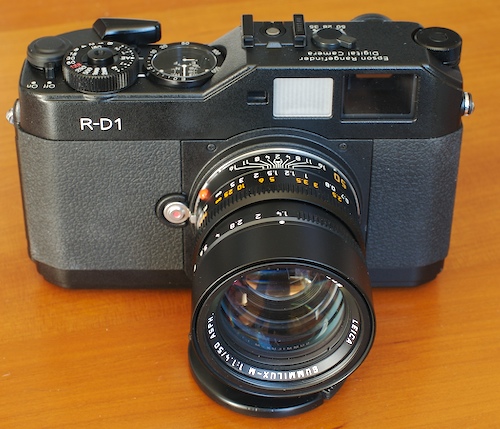Glimpsed at Chicago O’Hare airport


As far as I can see, the answer is yes.
About a month ago, my two-year old Windows PC game machine started crashing every two minutes in NWN2. This proved the last straw, and I decided to upgrade. One of the games I have, but seldom play is Oblivion, which is graphically gorgeous, but chokes on anything but the most powerful hardware at ordinary resolutions, let alone my Apple Cinema Display HD’s 1920×1200, and cutting-edge video cards are no longer available for the AGP bus in any case.
I looked around for packaged solutions from systems integrators, specialized gaming PC companies like AlienWare, and Dell. Contrary to conventional wisdom, it is still much cheaper to build a PC from components than to buy one from a major vendor, $1500 vs. $2500 minimum. Part of the reason is that the vendors flag anyone wanting the absolute best video card as a “cost is no object” customer, add all sorts of expensive components that make no sense in a machine that will only ever be used for games, like fancy DVD burners or flash card readers to jack up the profit margins. As if anyone in his right mind would use a Windows computer for serious work like digital photography…
My configuration is the following: a relatively quiet Antec Sonata II case, an Abit KN9 Ultra motherboard, an AMD Athlon x2 5200, 2GB of Kingston DDR-800 RAM, a humongous nVidia GeForce 8800GTX video card, a 500GB hard drive and a basic DVD-ROM drive.
When it came to choosing the OS, after much trepidation I opted for Vista Home Premium because the 8800GTX is one of the few cards that support DirectX 10, which is a Vista-only feature. I knew Vista would embezzle half the processing power of one core in DRM code that is actually working against my interests, but then again nobody in his right mind would use DRM-ed formats, whether Microsoft or otherwise, to store their music library, so the damage would be limited. Also, Vista comes with “downgrade rights” which allow you to legally install the previous version of Windows.
Vista comes in an attractive copper-colored DVD that is actually quite elegant. Its color scheme is also far superior to the molten Play-Skool set monstrosity that is XP. When I started the Vista installer, I was pleasantly surprised by how quickly it dealt with hard drive formatting (the previous Windows I installed myself is Windows 2000, which will insist on a time-consuming full format instead of the quick format used by the XP or Vista installers). The good impression lasted for all of five minutes. After the inevitable restart to complete installation, the screen promptly dissolved into a scrambled red-and-white screen of doom (I did glimpse a blue screen of death shortly before it rebooted). The diagnostics were completely unhelpful, as could be expected. When the operating system cannot even install itself, you have got to wonder…
Dejectedly, I fished out a Windows XP install DVD. it would not accept the Vista serial number. So much for downgrade rights. Of course, since the package was now opened, no hope for a refund either. I ended up buying a copy of Windows XP, which installed without a hitch. Of course, I still had to install the video drivers, but it did not crash half-way through the install procedure. And Oblivion is now playable without agonizing stutters every two paces.
The 8800GTX is very recent hardware, which did not even have non-beta Vista drivers when I installed it, so I could understand the OS falling back to SVGA mode. There are no other really exotic components here, certainly nothing than XP SP2 could not deal with and therefore Vista should as well. The machine is also well within the recommended minimum configuration (although some experts now advise 4GB of RAM as a realistic minimum for Vista). Crashing during install, when a five year old OS like XP handles it just fine, is simply unacceptable in my book. Even Solaris 10 Update 3, an OS notorious for its limited hardware support, installed without a hitch. Despite the ten man-millennia Microsoft invested in this lemon, they apparently could not be bothered to test the installer.
Conclusion: unless you buy a computer with Vista pre-installed, avoid it like the plague until SP1 is out, just like Intel.
Post scriptum:
Actually, I would not even recommend a PC with Vista preinstalled, as it has terrible backward compatibility. It will not run Office 2000, which is what my company has, for instance. Joel Spolsky has an excellent article on how the new, bloatedly bureaucratic Microsoft lost its way by sacrificing backward compatibility on the altar of useless marketectures. Perhaps they are just trying to force-upgrade people to Office 2007. They should beware: unlike 2002, people have credible alternatives now.
Update (2007-08-30):
The paper about how Vista eats up CPU on DRM has been criticized by the generally reliable George You. My point about the inability to even install on a modern machine that XP has no problems with remains. In any case, having the operating system constantly eat up CPU on tasks I do not want it to, whether it is 7% or 100% of one core, is still morally no better than a parasitic botnet.
Like many people, I keep a server running at home 24/7. In my case, it’s an old but relatively quiet Compaq Evo D315 AMD Athlon XP2000 PC with 1GB of RAM, 750GB total disk space and running Solaris 10. It serves as my personal email server (Postfix and Dovecot), to run Temboz, and miscellaneous auxiliary services like DNS, SNMP or being a staging point for off-site backups via rsync. All in all, very light usage, less than 5% average CPU utilization.
I have a Kill-a-Watt power meter measuring the load on that shelf, and the server, along with other devices on standby power, consumes about 160W. At PG&E’s marginal rate of $0.13 per KWh, that comes to $180 a year, or half the cost of the machine itself. I am thinking of upgrading to a machine with 6 750GB or 1TB drives in a 4+2 redundant RAID-Z2 configuration for reliable backups (the current setup runs on ZFS for snapshots but has no provisions for drive failure). I will definitely look at power consumption more closely in my decision process
Update (2007-08-25):
I ended up getting a Sun Ultra 40 M2 dual-core AMD Opteron workstation with 6 additional Seagate 750GB drives. It is remarkably quiet and consumes only 160W, which is pretty good since it does have 7 drives spinning inside. ZFS benchmarks at 160MBps sustained disk I/O…
One of the perks of living in San Francisco is easy access to MacWorld Expo. I can literally see the Moscone center a mere two blocks from my new office window. This year’s show spanned both North and South halls, but in some ways was a let-down compared to the last two.
Of course, all the buzz was about the iPhone. The amazing thing is not that Apple should make one, but rather that not a single cell phone manufacturer has a clue about design and ergonomics. Nokia used to, but they have backslid badly with their sluggish and over-complex Series 60 allegedly smart phones.
The prototypes were securely held under glass bells, presumably to preserve them from the salivating legions of the Mac faithful. From the demos, it looks pretty snappy compared to the incredibly sluggish Symbian or Windows Mobile equivalents, but I have serious doubts as to whether even Apple can make on-screen virtual keyboards work.
The other marquee product is the Apple TV, essentially a severely anorexic Mac mini without an optical drive or separate power brick, and running an unspecified embedded OS with the Front Row user interface. Pity it is limited to 720p (the 1080i support is interpolated). At a time when CompUSA sells a top of the line 42 inch Sharp Aquos 1080p LCD flat panel for under $2000, the lack of 1080p support is puzzling.
I haven’t seen that much innovation among the third party vendor stands either. Here is what I did find at least somewhat noteworthy:
Last Saturday, I became the proud owner of a Leica M8. Then, a not-so-proud owner. As of yesterday, an ex-owner…
I returned it and sprung for an Epson R-D1 instead, saving almost 50% in the process. I had already previewed one at MacWorld SF two years ago.

Most people interested in a M8 know by now about its problems with sensitivity to near infrared, which manifests itself as a magenta cast in certain situations. There is a work-around (buy costly Heliopan or B+W IR filters for your lenses, although there are rumors Leica will provide two free filters), but many are legitimately angry at Leica for having rushed the M8 launch despite such a fairly obvious flaw. It’s not an ideal situation but I could deal with it, as long as Leica stood behind its product and committed to a free upgrade to the corrected model once a definitive fix becomes available.
The straw that broke this particular camel’s back was quality control, however, or the lack thereof. My M8 exhibited almost an entire column of dead pixels (the bottom 3/4 at x=2888). If you must, see this jpeg or the original DNG. This kind of flaw would be unacceptable in a sub-$1000 Canon or Nikon, it is simply outrageous in a camera as expensive as the M8.
The magenta cast is not an edge condition visible in limited conditions, by the way (Leica claims it only affects black synthetics under tungsten light), the photos I took last Sunday indoors in available light are completely unsalvageable, with a strong magenta cast everywhere that cannot be corrected by any amount of custom white balancing. Here is an example: JPEG, DNG.
Last, but not least, noise levels are excessive at ISO 1250, let alone 2500, with smearing in rows where bright highlights are present. Essentially, this camera as it stands today is utterly useless outside broad daylight conditions (I don’t have an IR filter, so I can’t comment on how effective they are). Of course, pretty much all cameras do reasonably well in daylight, even cheap and nasty point-and-shoots with too many megapixels crammed in a sensor too small. Rangefinders give you a two stop advantage due to the absence of mirror slap, but even with a Noctilux, the M8 has no edge over a Canon DSLR because of the noisy sensor. Then again, it is one of my rules of photographic thumb that Kodak stands for poor quality, and since they make the sensor in the M8, I should have expected the worst.
It’s interesting to note how the reviews published so far managed not to mention any of these problems, which are completely obvious, even with the most cursory of inspections. In at least one case (Michael Reichmann of The Luminous Landscape), the reviewer found out about the IR issue, informed Leica about it but neglected to mention it in the review. This confirms me in my belief Phil Askey’s reviews at DPReview are the only reliable online reviews of digital cameras.
Leicaphiles seem to be mostly in denial, or minimize the extent of the problem. I am as big a fan as any of Leica’s optics and their rangefinder cameras, but the flaws in my M8 were so glaring I can’t even begin to fathom the levels of cognitive dissonance required to sustain a positive opinion of this train wreck in the making.
All the reviews I have read so far have been raising hallelujahs and claiming the M8 feels like a real Leica M. It most certainly does not:
 After using the R-D1 for a few hours, the superiority of the design over the M8 is readily apparent (with the sole exception of the taller body and short rangefinder base length):
After using the R-D1 for a few hours, the superiority of the design over the M8 is readily apparent (with the sole exception of the taller body and short rangefinder base length):
One bright light in this fiasco: Doug Thacker at Calumet Photo San Francisco (above) went well above the call of duty to help me with my purchases, all with unfailing good humor (he once sent me an email at 11PM to let me know of the IR sensitivity problem before they started receiving theirs). He even set one M8 aside for me even though I had cancelled my initial pre-order (they are in short supply and are reportedly going for over $6000 on eBay right now, so the opportunity costs are considerable). I think I will switch from B&H to Calumet for the bulk of my photo purchases in the future.
Update (2007-08-25):
I must be a glutton for punishment, as after reading Phil Askey’s M8 review, remarkably thorough as usual, I decided to give it another chance and get one for my birthday. The first one I ordered (from Amazon) had a severely misaligned rangefinder – points at infinity would not coincide at all when the lens was at infinity focus. It had a low serial number, suggesting an early model with teething problems. Presumably Amazon does not sell that many, so I returned it and ordered another one from a place with much higher turnover, B&H. That one was a recent vintage (they have an orange sticker on the body cap), but its rangefinder was also misaligned, if not as severely.
In frustration, I went to my local Calumet and finally found one that focuses correctly. Wonder of wonders, it even seems like there are no dead pixels or highlight streaks. Conclusion: Leica’s M8 quality control is still spotty, your best bet is to buy locally and test the rangefinder in the store itself.